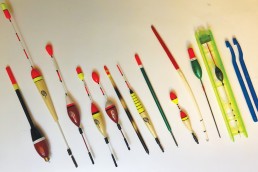Choosing the Right Float for Successful Fishing
SHARE THIS POST
Fish flying through the air, and big fish bending rods attached by a spider’s web—that’s float fishing. According to Johnny Wilkins, the difference between bobbers and floats is that floats talk and bobbers just slunk.
I speak a lot about the technical aspects of float fishing, but often forget to talk about the basics. Floats are thin and light. Bobbers are round, and some have a tube through the middle. Bobbers require a lot more weight than floats, and some even come with heavy lead attached at the bottom. The size and shape of these, and the amount of lead needed to sink bobbers, makes them poor choices to catch more and larger fish.
You need to get smaller, thinner and lighter (sounds like my new year’s resolution). Look in your tackle box, and if you have round plastic red-and white-bobbers, or the kind that have a tube through the center, you will need to improve on these.
A common misconception is that the center tube slip bobbers are “finesse” fishing. False. Use these only for drift bobbers and for big baits. You can also use these if you don’t want to be bothered by fish. Chunky bobbers and center tube slip bobbers will make sure that you don’t get bathed by too many fish. I mean, if you are into relaxing or napping.
The physics of a proper float setup have the float (only) attached at the bottom. This is better for casting and much better for seeing a bite. Because the connection is to the base of the float, the movement will send you bigger signals and earlier indications that fish are there. If you use small floats like the Gapen 5-inch Pencil float, you can actually see when fish are near the hook.
Yes, I said near. Did you know that 30 percent of the time, a proper little float will show a “lift” bite. Weighted bobbers or slip bobbers can not show this bite.
This attack and bite occurs when the fish picks up the bait or swims from beneath the bait. Fish often ambush a bait from below, which results in the smaller floats rising up in the water. Boom! That’s a fish on a float. On a bobber, you see little to nothing. On a bobber, they can spit your bait back out and you would never know it.
Float materials are made from “faster” and lighter materials. The speed comes from the bite indicator’s ability to “pop” quickly. This is great for you to add more indications and earlier signals that a fish is near, about to strike. Good, fast floats give you instant bite indication, and they let you know the instant a fish makes a move on your bait. Chunky bobbers and tube bobbers take longer to show this. Slow means, plastic air-filled or heavy-weighted bobbers, which don’t signal. These lay low in the water and require more movement to force or budge them.
Are you enjoying this post?
You can be among the first to get the latest info on where to go, what to use and how to use it!
The lighter, smaller and faster floats will go under when fish are in regular, normal and soft feeding moods, which is the majority of the time. Fish only use a soft vacuum to get their food.
The simplest setup for a float is some small split shot and one tiny split shot down above the leader and swivel. I use only good quality split shot (harder to find in stores) such as Anchor brand or Super Doux, and these are pure, soft materials. These brands won’t slide up and down the line because the quality material sticks in place. These shot won’t damage your lines like the cheaper brands found everywhere, which nick the line with harder edges.
For float fishing line, I like a very long rod that is specifically built for float fishing. This rod is stiff up the blank and also fast action. The Gapen10 is a 10-foot rod made with three wraps of Kevlar and Boeing top-quality carbon graphite wraps. This means casting farther and more accurately, and very fast hooksets. Fishing line is a 4-pound main line with either a 2- or 3-pound leader line, which is about 6 inches long below a swivel.
Premium-quality hooks are a must. I tie my own leader-and-hook combos so that I can pick the line thickness or change to fluorocarbon leader that’s invisible in clear water. If there are weeds or structure or powerful fish like steelhead or medium-sized cats, I will float fish using a 6-pound main line and either a 5- or 6-pound leader, so that I have some leverage in the weeds.
I play big fish using the big spinning rod (very powerful with the Kevlar and carbon), and I also flip the anti-reverse switch on the back of my spinning reel. When the fish makes a speed run, I reel back at the fish and manually control the pressure to prevent break-offs. Pick a 400 or 4000 series reel which gives you a big spool; these cast best and pick up line faster than the small reels. This reel balances perfectly with the Gapen10 rod.
If you want to try some new fishing techniques, look for more suggestions in the spring issues of MidWest Outdoors, available the first full week of each month at the newsstand or by subscribing on our website.
MWO
SHARE THIS POST
You may also like...
Nothing found.
Did you enjoy this post?
You can be among the first to get the latest info on where to go, what to use and how to use it!
Johnny Wilkins
MidWest Outdoors works with more than 200 outdoor experts each year, who contribute articles based on their areas of expertise. MidWest Outdoors magazine offers more fishing and hunting articles than any other publication!
